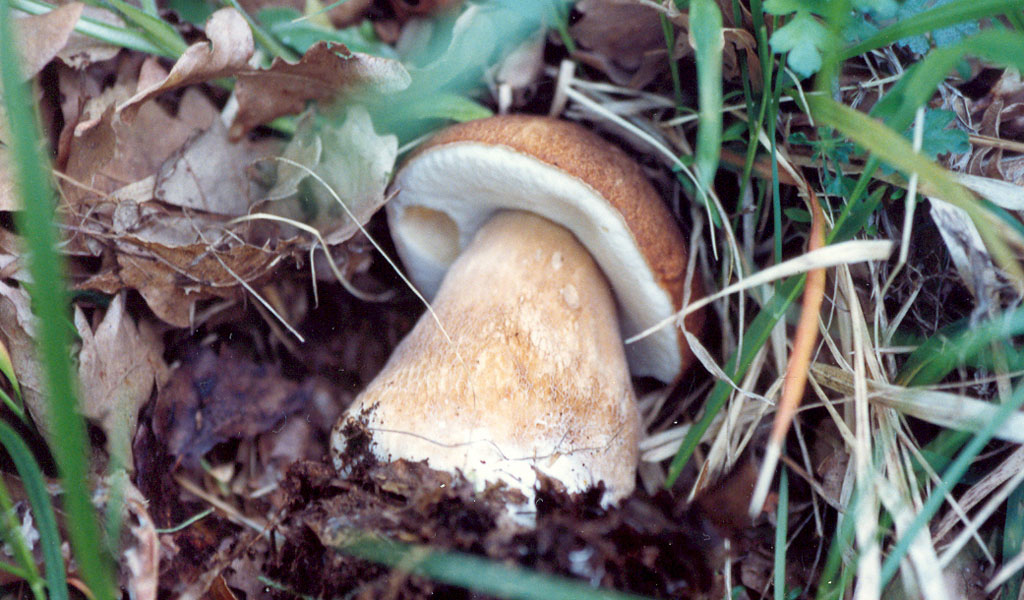Prodotti tradizionali
Fungo Porcino del Vulcano di Roccamonfina

Il Fungo porcino del Vulcano di Roccamorfina è un prodotto del territorio dei comuni del Parco Regionale di Roccamonfina, in provincia di Caserta, ed in particolare dell'area di Monte La Frascara, dove questo particolare fungo cresce nei caldi boschi di latifoglie: il territorio è, infatti, composto da rigogliosi boschi di castagno, che offrono, nei mesi primaverili ed autunnali, un habitat molto favorevole per la crescita di questo autentico e genuino porcino, caratterizzato da un gusto particolare ed esclusivo, dovuto anche alla natura vulcanica del terreno. Il porcino di Roccamorfina è caratterizzato da cappella di colore marrone scuro variabile a seconda delle specie del sottobosco e del bosco di raccolta, mentre il gambo è di colore marrone chiaro. Ha polpa bianca e soda ed il suo sapore è delicato ma intenso, a tal punto da permettere di riconoscervi tutti i profumi del sottobosco. è presente in diverse pezzature, che variano a seconda dello stadio di sviluppo e raggiungono un massimo di 30 centimetri. Questo fungo matura da fine primavera ad ottobre e per la raccolta esistono procedure atte a salvaguardare la qualità della specie: è, infatti, vietato l'uso di rastrelli, uncini o altri mezzi che possono danneggiare lo strato umifero del terreno, il micelio fungino o l'apparato radicale della vegetazione. Dopo la fase di raccolta i porcini di Roccamorfina devono essere riposti e trasportati in contenitori idonei a consentire la diffusione delle spore come, ad esempio, i cesti di vimini. I porcini di Roccamorfina vengono venduti tradizionalmente freschi, essiccati o sott'olio, a seconda dell'uso che se ne farà. Il porcino fresco, dopo la pulizia con uno spazzolino, si presta ad essere utilizzato come condimento per vari piatti locali o come contorno. Essiccato, al sole o con appositi essiccatoi, viene conservato in barattoli ermetici o sacchetti, in modo tale che conservi il suo sapore gradevole ed il colore bianco, e viene sfruttato per la preparazione di diverse ricette. I porcini sott'olio, subiscono una preparazione più lunga: vengono, infatti, lavati a mano per eliminare impurità ed eventuali residui presenti e poi tagliati o lasciati interi, cotti con aceto, acqua e sale, e, successivamente, conservati in vasetti con aggiunta di olio.
Fungo (mushroom) porcino of Roccamonfina Volcano is a product from the territory belonging to the regional Park of Roccamonfina, in the province of Caserta, and in particular to the area of La Frascara mountain, where this particular mushroom grows in the warm broad leaf trees forests; the territory has luxuriant chestnut forests that offer, during the spring and autumn months, a favourable habitat for the growth of this authentic and genuine porcino, characterised by a strong and exclusive taste, thanks also to the volcanic nature of the soil. The dark brown cappella that changes according to the brushwood and the forest it grows in, and the lighter brown stalk, characterize Porcino di Roccamonfina. It has a white and firm pulp and its flavour is delicate but intense, to the point that one can recognize all the flavours of the brushwood. It can be found in various sizes, which change according to the level of growth to a maximum of 30 cm. This mushroom matures between the end of spring and October and there are picking procedures aimed to preserve the quality of the species: it is hence forbidden to use rakes, hooks or other means that could damage the rich in humus stratus of soil, fungal mycelium or the radical apparatus of the vegetation. After being picked the porcini of Roocamonfina must be laid and transported in containers that allow the diffusion of the spore, like a wicker basket. Porcini di Roccamonfina are traditionally sold fresh, dried or preserved in oil, according to the use they are devoted to. Fresh porcino, after being cleaned with a small brush, can be used as condiment to many local dishes or as a side. Dried, either in the sun or in kilns, it is preserved in hermetically closed jars or bags, to maintain its pleasant taste and the white colour, it is used in many of recipes. Oil preserved porcini go through a longer preparation: they are hand washed to eliminate all impurities and residuals and then cut or left whole, cooked in vinegar, water and salt and later preserved in jars filled with oil.